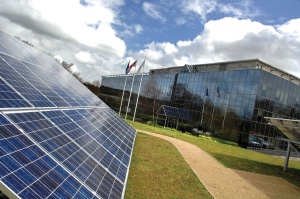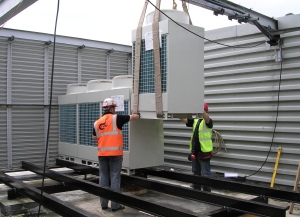From an E to B DEC — with the help of renewable energy

Renewable energy is just one off-the-shelf solution that helped Mitsubishi Electric steadily improve the energy performance of its headquarters building at Hatfield, as Martin Fahey explains.
Much of our future built environment already exists. Whilst regulations are helping increase efficiency in new buildings, we have to find ways of tackling the old and energy-inefficient properties that will continue to form the bulk of our building stock. It is estimated that 80% of existing buildings are likely to still be in use in 2050
Initial changes to lower the carbon footprint and energy consumption of a building can often be achieved in cost-effective ways, such as better insulation or more control over the timing and use of energy-consuming equipment. This aspect is a vital first step, and everyone should look at ways of reducing the need for energy consumption in the first instance.
However, once you have gone through the obvious, it then becomes a matter of looking at the plant and equipment you are using to provide a comfortable, profitable and pleasurable internal environment — and this is where businesses can face the challenge of justifying any capital outlay.
Like any other company, Mitsubishi Electric has to make a business case for investment — particularly in fixed assets like our headquarters building at Hatfield.
However, we have been able to demonstrate both the business and the financial case for improving the services to our building over the past 10 years, and this has seen us transform a standard 1980s office block from an estimated ‘E’ energy rating to a certified ‘B’ rating, using readily available, off-the-shelf technology.
 |
| 40 kW of solar PV has significantly reduced the electricity taken from the National Grid. |
There are lessons to be learnt here for all.
We have occupied our Hatfield headquarters since the late 1980s. The steel-framed, glass-fronted, 3-story office block is typical of the era. We knew that we should try to improve its energy efficiency, not only to reduce energy consumption and our carbon footprint, but also to use it as a clear example to others.
Like all companies we have to justify all capital expenditure, so what we have done is put in place an ad hoc programme to upgrade the building services when they need replacement or when additional budget becomes available.
It has been an evolution, rather than a revolution, but it has got us much closer to where we want to be as a company. It has also helped reduce running costs whilst giving us more control over our internal environment.
Like most 1980s offices, our building had a chiller for cooling and a gas boiler for heating. With a chiller that was getting on a bit, we chose to replace it with a VRF heat-recovery air-conditioning system to heat and cool in a more balanced and controllable way, whilst helping to recover heat for use in other parts of the building.
Using the air conditioning to provide heating also reduced the load on the boiler, relegating it to the domestic hot water . . . albeit temporarily.
Over the years as heat-recovery and heat-pump technology have developed, we have simply added more efficient and renewable equipment.
We added a VRF ground-source heat-pump system for one wing of the building, which not only introduces a significant element of renewable heating but also allows us to use the site as a showroom. Adding a VRF air curtain on the front door has also meant that we can ensure we don’t lose energy every time we have a visitor.
 |
| VRF technology is improving energy efficiency. One wing of the building is served by a ground-source heat-pump system. |
The introduction of a VRF heat pump to provide hot water for our kitchen for washing up and Ecodan air-source heat pumps to deliver hot water to the toilets has meant that we have also been able to remove the old gas boiler. The only gas on site now is for the kitchen’s cookers; even here, the excess heat generated in the kitchens is used to preheat the water for washing up.
Securing agreement for a major investment in solar PV now sees a 40 kW array of 220 panels on the building’s roof, which has significantly reduced the electricity we have to take from the National Grid, whilst also earning an income from the Feed in Tariff.
Having recently entered the air handling unit (AHU) market with our Lossnay Kanzen, we replaced the old, inefficient system and this is also helping to reduce overall energy consumption, whilst delivering a controllable, comfortable indoor environment for our staff.
All these changes have been introduced in a controlled, managed and budgeted way that any company could replicate.
We know that there are more things we can do, particularly with regards to the lighting, which we are updating as we refurbish individual parts of the building. New lighting will be controlled passive infra-red systems so it only comes on in occupied areas.
However, any change to the building’s cladding will require a major upheaval, so we also know that we are unlikely to ever get the building to reach an ‘A’ rating as this may simply be a step too far in terms of cost and disruption to the business.
In this sense. therefore, zero carbon may simply not be possible for many existing buildings, but there are still significant steps that any building owner can undertake to bring down running costs and maximise efficiency.
For me, the important lesson is not what we have achieved as an individual company, but that we did it with technology that is available right off the shelf today.
If we can get more businesses to replicate this process, then over time, we can help existing buildings to make a considerable difference to the nation’s energy performance, and affect their own individual running costs.
Martin Fahey is sustainable solutions manager at Mitsubishi Electric.








